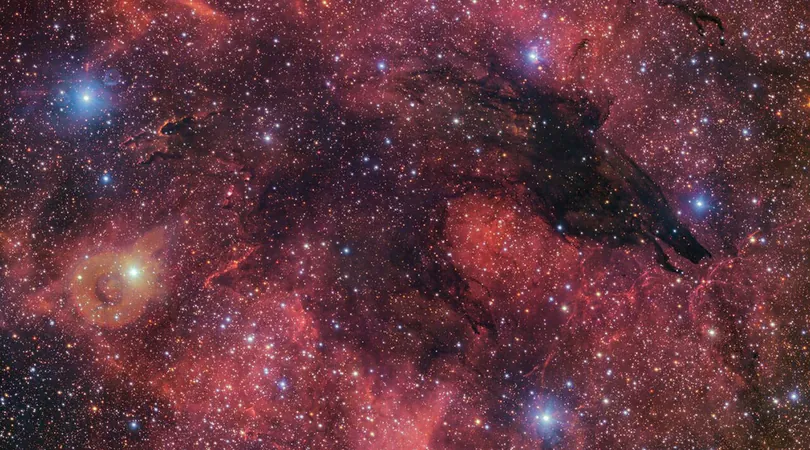
Unveiling the Spine-Chilling “Dark Wolf Nebula” Just in Time for Halloween!
2024-10-31
Author: Arjun
Introduction
As Halloween approaches, the European Southern Observatory (ESO) has delighted stargazers with a breathtaking image of a nebula that strikingly resembles the eerie silhouette of a wolf, set against a dazzling backdrop of stars. This captivating cosmic artwork, aptly named the “Dark Wolf Nebula,” is not only a feast for the eyes but also a fascinating subject of scientific inquiry.
Capturing the Image
The stunning visual was captured by the Very Large Telescope Survey Telescope located at the Paranal Observatory in Chile. It boasts a staggering 283-million-pixel resolution, allowing viewers to appreciate the nebula's intricate structure like never before. This celestial beauty is situated in the constellation Scorpius, approximately 5,300 light-years away from Earth, and is part of a larger nebular formation known as Gum 55. The detailed image covers an area in the sky roughly four times the size of the full moon, despite being just a small segment of the vast molecular cloud that contains the Dark Wolf.
What Are Dark Nebulae?
Often mistaken for empty spaces in the universe, dark nebulae are actually dense clouds of cold interstellar dust. This dust blocks light from stars and other objects behind it, creating the shadowy appearance that defines these intriguing formations. Unlike other types of nebulae, dark nebulae do not emit visible light; their dust grains interact with light, absorbing and scattering it, which results in those haunting silhouettes. Interestingly, longer wavelengths like infrared light can penetrate these dust clouds, providing astronomers a way to study the hidden regions of the cosmos.
Moreover, dark nebulae act as vital nurseries for star formation. Within these dense clouds, new stars are born, offering astronomers invaluable insights into the early developmental stages of stellar evolution. The eerie wolf-like figure of this nebula is set against glowing hydrogen gas, illuminated by ultraviolet radiation from newly formed stars, enhancing its spectral appearance.
The Power of the VLT Survey Telescope
The breathtaking image of the Dark Wolf Nebula was captured using the VLT Survey Telescope, a cutting-edge instrument tailored for producing high-resolution images of extensive areas of the southern sky in visible light. Nestled within the Atacama Desert of Chile, this telescope enjoys some of the clearest skies in the world, making it ideal for astronomical surveys.
The telescope has processed over 500 million celestial objects through various optical filters to pinpoint different sections of the light spectrum. This meticulous approach allows astronomers to emphasize specific features within nebulae, including the ghostly form of the Dark Wolf.
A Spooky Cosmic Reveal for Halloween
As the eerie festivities of Halloween kick in, the ESO’s release of the Dark Wolf Nebula compellingly showcases the haunting beauty of our universe. Its ominous shape, contrasted against vibrant hydrogen clouds, invites us to look deeper into the hidden, often shadowy realms of our galaxy.
With ongoing observations and advancements in technology, the future holds exciting possibilities. Who knows what other spectral figures might be lurking amongst the stars? As we gaze upward, the cosmos continues to surprise and enchant, giving the season a truly astronomical treat!




 Brasil (PT)
Brasil (PT)
 Canada (EN)
Canada (EN)
 Chile (ES)
Chile (ES)
 España (ES)
España (ES)
 France (FR)
France (FR)
 Hong Kong (EN)
Hong Kong (EN)
 Italia (IT)
Italia (IT)
 日本 (JA)
日本 (JA)
 Magyarország (HU)
Magyarország (HU)
 Norge (NO)
Norge (NO)
 Polska (PL)
Polska (PL)
 Schweiz (DE)
Schweiz (DE)
 Singapore (EN)
Singapore (EN)
 Sverige (SV)
Sverige (SV)
 Suomi (FI)
Suomi (FI)
 Türkiye (TR)
Türkiye (TR)